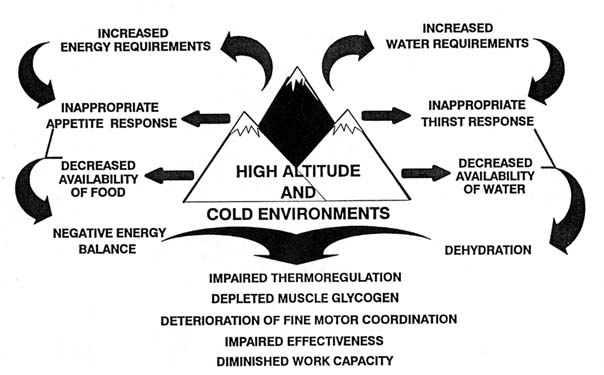Cold Survival Tactics for Frozen Truckers in the Wake of 2018’s Winter Storms
By Matthew Harvey
Early 2018 brought what meteorologists described as a “Bomb Cyclone” to the East Coast, which led to record-breaking freezing temperatures across the country. The Niagara Falls even froze over, and dozens of deaths were reported.
To add insult to injury, Winter storms continue to ravage the south while the west readies itself for Winter Storm Jaxon.
Cue panic buying of Milk and Bread…
Grocery stores across the Nation were terrified by the thought of the shipment that would never come, and many feared having to wait until being thawed out before they would receive their necessities.
American trucking, however, never stops. That leaves truckers, who keep this country moving, facing some of the most unforgiving frost to ever grip the country.
To those brave men and women who will be on the icy roads this month, we bring you a list of survival tactics so you can brave the winter storm:
Any product suggestions in this post are unsolicited. We were not paid to advertise these products.
Layers
Hands and Feet
Head Wear
Fuel in the Tank
Stay Active
Warm Ups
Protection
Emergency Kits
Snow Shoveling
Truck Technology
Smartphone Applications
-
Layers
Wearing layers is the number-one advice for dressing warm in the winter. But which layers go where?
Start with a piece of clothing made out of synthetic material that can wick sweat from your body. Natural fibers like cotton can hold moisture and keep you wet, leaving you cold. Try polyester blends like Polypropylene which pull moisture from the body to the exterior of the shirt, where it will evaporate.
A middle layer should be used if it’s especially cold out for insulation. A polar fleece or level-4 thermals should keep you warm, even in this record-breaking chill.
Lastly make sure to include an outer layer of nylon or Gore-Tex, which will not only keep you dry but also protect you against wind chill.
It’s also advisable to keep an extra change of clothes, in case one gets wet during loading or unloading of hauls. Keeping dry is the most important factor in staying warm, after all.
-
Hands and Feet
You know how important keeping your hands and feet warm during the winter is! After all, humans lose upwards of 30% of the heat from their bodies from hands and feet.
But it’s 2018, which means your winter sock and glove game could probably use some updating.
For your feet, the traditional advice was to use a sock liner for moisture followed by a wool sock for warmth. But socks have evolved, and many exist with moisture wicking properties that will still keep you plenty warm.
Aim for a sock made of Merino Wool, which has both anti-moisture and anti-microbial properties. Generally, merino wool base layer products can be worn for days, if not weeks at a time without needing a wash. Plus they’re not itchy like regular wool and will still keep you warm. Here’s a solid pair from Amazon at less than $20.
As for your hands, it’s time to get some gloves that work with your smartphone — and I’m not talking about gloves without fingertips!
There are tons of gloves out there which have been specially designed with conductive fabric so you can continue typing, even with them on. That way, you don’t have to remove your gloves to send that text, or look at your phone’s map. This is a good choice for touchscreen gloves from Amazon that will set you back less than $10.
-
Head Wear
The human skull has relatively thin skin and a lot of blood flowing through it. That means it allows heat from blood to escape more quickly than other areas of the body.
While old claims humans release the “majority” of body heat through the head are misleading, it’s still important to keep your head warm this season.
A winter cap or beanie made of fleece will do the job in most situations. Pair that with a scarf and one would be prepared for winter most anywhere. But for the particularly frigid temperatures this season, one may want to spring for something even better.
Balaclavas (like this one from Amazon, ~$15) are often worn by skiers and will keep your head, face, and neck warm. Generally a good option for the especially cold winter, but maybe not for truckers spending most their time inside the cab.
These Ushanka-Style Hats (from Amazon, ~$20) offer a little more versatility, with ear muffs and a removable face mask to keep the cold away from the most sensitive areas while outside. A polyester outer shell will keep you dry, and the chin-strap will keep the hat in place while loading or unloading hauls.
-
Keep Fuel in the Tank
Keeping your truck properly fueled at the right cost is undoubtedly important, but we’re talking about the driver’s fuel tank here. Check out our review of the smartphone app GasBuddy below for information on keeping your truck fueled.
Generally, as temperatures drop, our need for food and caloric intake increases. Cold stimulates the appetite: experience a drop in temperature or a chill, and you might find yourself searching for food. The body also generates 10% more heat 30-to-60 minutes after eating than compared to an empty stomach.
Therefore it’s especially important to keep stocked up on calorie-heavy and fat-laden foods during the winter: it’s not just for giving you energy, it’s also for staying warm.
That’s why Winter campers often keep nutritional snacks stored away for a boost of fuel. Snacks like dried fruit, candy bars, nuts, and granola can be great sources of emergency fuel.
Some other alternatives include protein/nutrition bars, peanut butter, jerky, and canned meats. These are chock-full of fat and calories, and often keep for long periods of time, making them ideal for the person on-the-move.
While our need for food increases in cold temperatures, the same is not necessarily true for water. Our need for water does not increase as the temperature drops.
Our body’s response to thirst, however, does become impaired in colder environments, which may lead one to not drink as much water as needed. With the increase in dryness from the cold, therefore, it’s especially important to regularly quench your thirst. General advice is to drink around a half-gallon of water each day, but more if exercising.
There are many risks associated with not properly “fueling up.” Both dehydration and improper nutrition can lead to poor bodily thermoregulation, deterioration in fine motor skills, decreased mental capacity, and drowsiness.
-
Stay Active
Beyond keeping your body warm, moving and staying active has one important benefit for truckers: Staying awake.
Of course it can be very difficult to stay active while in the cab in-between hauls, especially in such frigid weather. Here are some simple ways to keep your body engaged, even while sitting:
-
- Foot Alphabet: Sit up straight with both feet on the floor. Raise one foot high enough to swivel in all directions. Then, with your big toe, write the alphabet. As you make letters, spread and curl your other toes. Repeat with your other foot.
- Cheek Scrunches: Sit up straight, and tighten your glutes (butt muscles) for 5-10 seconds. Relax, and repeat 5-10 times. Can even be done while driving.
- Deep breathing: Inhale as big as possible so both chest and diaphragm are full. Exhale slowly, letting out all the air in your lungs. Repeat for the duration of 1 song (or about 2 minutes). Can even be done while driving.
- Exercise your eyes: Dart your eyes between your mirrors, or from side-to-side and up-and-down for about 1 minute.
-
Warm Up to Avoid Muscle Strain
When it’s very cold out, humans experience a greater risk of muscle strain due to muscles losing heat and contracting. That leaves many with tight joints and lack of range-in-motion from their muscles.
One can avoid achy joints and sore muscles in the winter, however, through some proper warm ups that bring their body up to temperature before strenuous activity.
For truckers who drive long hours, this means making sure to leave room to warm up their bodies before loading and unloading hauls.
It’s recommended to warm up for about 10-minutes before strenuous activity when temperatures reach 35-45 degrees. Anything that gets the blood pumping and sweat dripping can be an effective warm up. Make sure, as well, to stretch lightly any muscle groups that seem tight. For most, this means hamstrings, quadriceps, and shoulders.
Check out Built Lean’s great 5-minute stretch routine that covers all the important muscle groups.
-
Protect Yourself
Many of us see overcast clouds in the winter and believe we’re protected from the sun’s rays. This is not so. Upward of 80% of the sun’s UVA rays penetrate winter clouds, meaning one might experience sun damage even on the cloudiest of days.
Added with the drying effect the winter season has on skin, sun-protectants are still very much necessary, if not even more so, during the winter.
That means it’s time to stock up on sunscreen and lip balm. Aim for products with added moisturizers to keep skin hydrated, and make sure to purchase at least SPF 30 (Our favorite winter-time lip balm is Carmex Medicated Cherry Lip balm — couldn’t live without it).
More than skin, however, winter is also a time to think about protecting your eyes. Glare coming off the snow and UV-rays coming through the clouds can still be damaging to your sight, so make sure to keep UV-protecting sunglasses handy. Eye drops are also essential for keeping dry eyes at bay, at a time where furnaces and heaters can dry out the air indoors.
-
Emergency Kits
Everyone should carry an emergency survival kit in their car, and the same goes double for truckers. In a serious emergency, especially in the freezing cold, it could save your life.
Many pre-packaged kits exist that will carry all essential items, but it can be more cost-effective and better-tailored to your specific needs to build your own kit.
Essential Winter Survival Kit Items include:
-
- A shovel
- Windshield scraper and broom
- Battery Powered Radio
- Flashlight
- Extra Batteries
- Water
- Calorie-rich snack foods with long shelf lives
- Waterproof strike-anywhere matches and candles
- First aid kit
- A change of warm clothes
- Essential medications
- Sleeping bag and space blanket
- Tow chain or rope
- Road salt or cat litter (for traction)
- Jumper cables
- Emergency flares
- Cell-phone charger with car-lighter adapter
-
Shoveling Snow?
For those that are stuck shoveling, snow buildup on your shovel can make the job even harder. For those of us armed with a little non-stick cooking spray, however, snow buildup is no more!
Just spray a little Pam or your favorite non-stick cooking spray on your shovel and say goodbye to snow-covered shovels.
-
Truck Technology
Truck technology has made tremendous strides to improve the lives and efficiency of truck drivers around the World. Prices and availability have followed suit, and now even the smallest mom & pop moving companies can afford to make some technological improvements to their vehicles.
Here are our top recommendations for getting your Truck ready for the Winter:
-
- Snow Chains are required by the California Department of Transportation (as well as many other states) to be carried on trucks when driving in chain-control areas. Truckers this winter will be chaining up all across the nation, but many will benefit from having Automatic Chain Systems installed. Automatic Icechains — like these from Insta-Chain — deploy in seconds from the flip of a switch right inside the cab. That means no more stopping to chain-up, or even leaving the driver’s seat!
- Jacob Engine Brake Systems (commonly known as the “Jake Brake”) are often installed on large diesel trucks. However use of the Jake Brake is not recommended on icy roads, as it can cause the truck to jackknife or spin sideways if the rear axle breaks traction. Check out Smart Trucking’s 20 Tips for Using the Jake Brake for more information on Jacobs Engine Brake Systems.
- Truck Lubrication and Fluids are even more important in the winter chill. After all, your truck really doesn’t like the winter. Tire pressures drop, things begin leaking, water in fluids freeze, and things rust; that’s why vehicle inspections, lubrication transfusion, and fluid topping-up is important before it’s too late. Make sure to stick with synthetic fluids for the winter, as they flow better at lower temperatures.
- Windshield Wipers are going to be your best friend while it’s snowing or raining, and you definitely don’t want to be caught in a storm with broken ones. It’s recommended to change Wiper Blades every 6 months. Wiper Blades even come in Winter/Extreme Weather varieties, which will perform at up to -20F weather.
-
Smartphone Apps
Smartphone applications for truckers have blown up, and go a long way in making everyone’s life easier on the road. Here are a few of our favorites:
- CamScanner: Dealing with physical documents and paperwork such as Bills of Lading, Trip Pay Sheets, and company paperwork can create complications for anyone, let along drivers in freezing temperatures. CamScanner creates digital files of all these documents using only your phone’s camera. Just lay it flat, snap a picture, and voila: your document is available in a multitude of digital formats. Avoid hassle, mistakes, legal issues, and delays by having access to all your documents at your fingertips, ready to be emailed or sent to anyone on a whim.
- Truckers Path: Makes trip planning easy. Find truck stops, weigh stations, parking, and even Walmarts with Truckers Path. Users can mark parking availability, open/closed weigh station, and review restaurant and truck stop quality, meaning you can stop at only the best, open, and available locations.
- Weather Route Free (only available on Android): Set start-and-end points, and Weather Route Free will give you a time-staggered list of basic weather events on your path. Even has a slider to adjust the shown times, making matching your schedule and preferred conditions easy.
- Cat Scales App: No more parking and going inside at weigh stations. Simply hook the app to a credit card, enter the code on the scale, see your weight, and pay instantly. Especially helpful in the wintertime or when in a hurry.
- Gas Buddy: Potential money-saver. Gas Buddy is a useful app not just for truckers, but anyone interested in finding the best places to get gas. Current prices are user-provided so often require updating, but still a useful app to look on a map for the best prices around.






